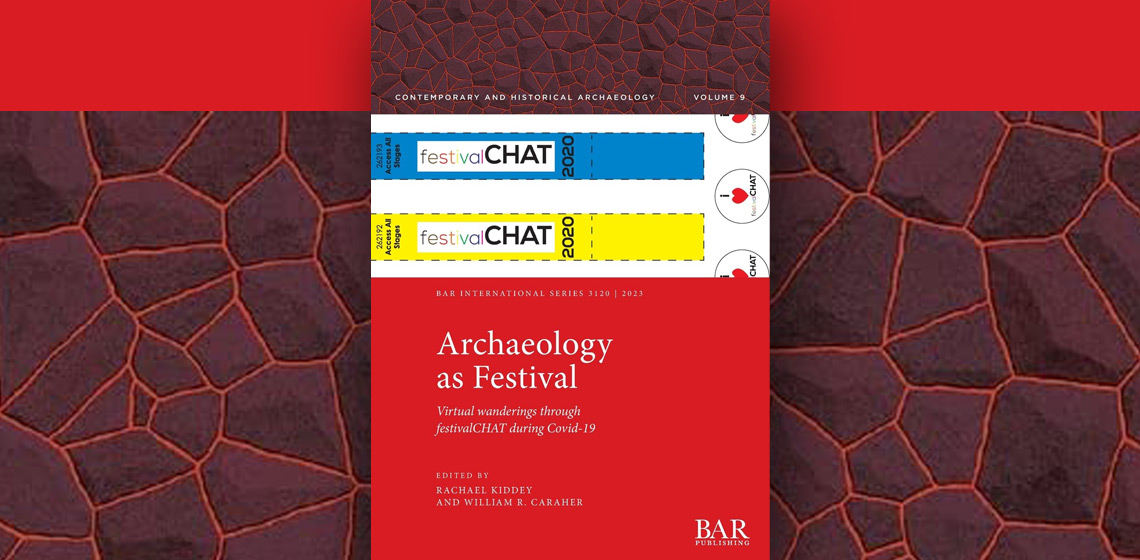The content is published under a Creative Commons Attribution Non-Commercial 4.0 License.
Unreviewed Mixed Matters Article:
Book Review: Archaeology as Festival: Virtual Wanderings through FestivalCHAT during Covid-19 by Kiddey and Caraher (eds)

Archaeology as Festival reports on the 2020 annual conference of the Contemporary and Historical Archaeology Theory group. It contains fifteen contributions and includes papers reporting on public stairways in Pittsburgh, toilet graffiti in Lisbon, and a kitchen wall in the Netherlands. With case studies like these one might doubt the relevance of the contents to the EXARC community, but there is much more to this fascinating volume than historical record, and its importance here, stems less from the detail of the subject matter and more from the circumstances in which it was produced.
As we all know, 2020 was the year of the Covid lockdowns and, in consequence, the 2020 CHAT conference was rapidly changed from an in-person event to be held in Santiago de Compostela, to an online event, and more than an event: a festival. The creativity, imagination - even daring, - of the organisers and participants shines out in contribution after contribution and encouraged this reader to think “I wonder if I too could be a little more daring in my practice.”
For example, in presenting the results of a survey into sexism within Swedish archaeology, Äikäs et al use bold cartoons and minimal text, making this reader feel their points more powerfully than might have been achieved by any number of graphs and tables. Similarly, in a piece on changing senses of geography during Covid, Mullins et al asks students to draw maps of their world during lockdown. Their maps – some scribbled, some artful – show how different minds experience life differently. In both these cases, the authors encourage experimentalism and in so-doing, they encouraged me to reflect on what lessons I might learn from them – if drawings, poems and colourings can work well for them, might they work as tools for use in visitor surveys, experiential practices, and staff feedback? Need everything require swathes of text?
Equally stimulating is a piece by Whitaker and Band, who organised a chain-letter art piece in which nineteen conference participants took part – a sort of paper chain of creative practice. It’s a fascinating idea that I suspect will stay with me for a while, until the moment when SI can draw upon its spontaneity within my own work: team-building for off-site volunteers perhaps? Maybe as an icebreaker before a project kick-off meeting? Who knows. That is, perhaps, the reason for reading this book. There is little here that will directly inform the undertaking of experiments, or the running of museums, but it definitely broadens the perspective when it comes to how each of these practices can be conducted.
Overall’s piece provides a good example of what I mean. She recounts a shared walking experience that she ran during the conference using what was then known as Twitter. The theme of the event was an exploration of local landscapes, inviting participants to consider how they might interpret their present surroundings in terms of folklore told by descendants of survivors of a future apocalypse. An archaeology of a future past. The responses posted by participants are absorbing and unsettling in equal measure and speak to a potential pathway for a playful visitor event that will certainly return to in the future.
So there it is: the most refreshing archaeology-related book I’ve read in some time, and one which throws down a challenge to all the online conferences and proceedings that follow. Dare we write poems, scribble maps, and expose our creativity to one another? Is there room for playfulness in our practice? Might our work be as much about new ways of relating to one another, as it is about rehearsing old familiar strategies for communication.
If these are questions which appeal, then festivalCHAT might just be the book for you too.
Book information:
Kiddey, R. and Caraher, W.R. (eds). 2023. Archaeology as festival: virtual wanderings through festivalCHAT during Covid-19. Oxford: BAR Publishing (Contemporary and historical archaeology, 9).

